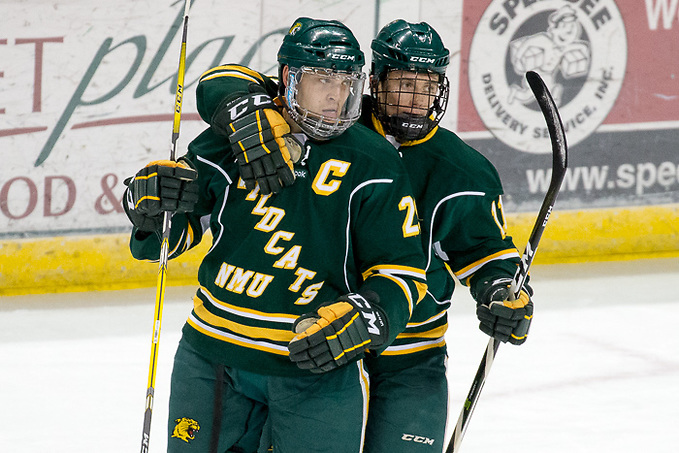
It’s time once again to do what we like to call Bracketology, college hockey style.
It’s our weekly look at how I believe the NCAA tournament might look like come selection time, using what we know now.
It’s a look into the possible thought processes behind selecting and seeding the NCAA tournament teams.
This is not a be-all, end-all analysis of the bracket. I am trying to give you, the reader, an idea of what the committee might be thinking and not exactly what they are thinking.
This will be the final Bracketology until we make our final picks before the field is announced on March 18.
If you want to skip the inner workings and get to the results of the analysis, then click here.
Here are the facts:
• Sixteen teams are selected to participate in the national tournament.
• There are four regional sites (East – Bridgeport, Conn.; Northeast – Worcester, Mass.; Midwest – Allentown, Pa.; West – Sioux Falls, S.D.).
• A host institution that is invited to the tournament plays in the regional for which it is the host and cannot be moved. The host institutions this year: Yale in Bridgeport, Holy Cross in Worcester, Penn State in Allentown and North Dakota in Sioux Falls.
• Seedings will not be switched. To avoid undesirable first-round matchups, including intra-conference games (see below), teams will be moved among regionals, not reseeded.
Here are the NCAA’s guidelines on the matter, from the 2015 pre-championship manual:
In setting up the tournament, the committee begins with a list of priorities to ensure a successful tournament on all fronts, including competitive equity, financial success and the likelihood of a playoff-type atmosphere at each regional site. For this model, the following is a basic set of priorities:
1. Once the six automatic qualifiers and 10 at-large teams are selected, the next step is to develop four groups from the committee’s rankings of 1-16. The top four teams are No. 1 seeds and will be placed in the bracket so that if all four teams advance to the Men’s Frozen Four, the No. 1 seed will play the No. 4 seed and the No. 2 seed will play the No. 3 seed in the semifinals. The next four are targeted as No. 2 seeds. The next four are No. 3 seeds and the last four are No. 4 seeds.
2. Step two is to place the home teams. Host institutions that qualify will be placed at home.
3. Step three is to fill in the bracket so that first-round conference matchups are avoided, unless it corrupts the integrity of the bracket. If five or more teams from one conference are selected to the championship, then the integrity of the bracket will be protected (i.e., maintaining the pairing process according to seed will take priority over avoidance of first-round conference matchups). To complete each regional, the committee assigns one team from each of the remaining seeded groups so there is a No. 1, No. 2, No. 3 and No. 4 seed at each regional site.
Given these facts, here is the top 16 of the current PairWise Rankings (PWR), and the remaining highest seeds in the tournaments through all games of March 14:
1 St. Cloud State
2t Notre Dame
2t Cornell
4t Ohio State
4t Denver
6 Minnesota State
7 Northeastern
8t Minnesota Duluth
8t Providence
10t Michigan
10t Clarkson
12 Penn State
13 Minnesota
14 North Dakota
15 Boston College
16t Bowling Green
16t Northern Michigan
20 Mercyhurst
Current highest remaining seeds BOLDED Above:
Atlantic Hockey: Mercyhurst
Big Ten: Notre Dame
ECAC Hockey: Cornell
Hockey East: Boston College
NCHC: St. Cloud State
WCHA: Northern Michigan
Notes
• Bracketology assumes that the season has ended and there are no more games to be played — i.e., the NCAA tournament starts tomorrow.
• The top seeds in each conference tournament are my assumed conference tournament champions.
Step one
From the committee’s report, choose the 16 teams in the tournament.
We break ties in the PWR by looking at the individual comparisons among the tied teams, and add in any current league leaders that are not currently in the top 16. The only teams that is not is Canisius.
From there, we can start looking at the ties and bubbles in a more detailed fashion.
The ties and bubbles consist of Notre Dame and Cornell at 2, Ohio State and Denver at 4, and Michigan and Clarkson at 10.
We break all of our ties based upon the RPI.
Therefore, the 16 teams in the tournament, in rank order, are:
1 St. Cloud State
2 Notre Dame
3 Cornell
4 Ohio State
5 Denver
6 Minnesota State
7 Northeastern
8 Minnesota Duluth
9 Providence
10 Michigan
11 Clarkson
12 Penn State
13 Minnesota
14 Boston College
15 Northern Michigan
16 Mercyhurst
Step two
Now it’s time to assign the seeds.
No. 1 seeds: St. Cloud State, Notre Dame, Cornell, Ohio State
No. 2 seeds: Denver, Minnesota State, Northeastern, Minnesota Duluth
No. 3 seeds: Providence, Michigan, Clarkson, Penn State
No. 4 seeds: Minnesota, Boston College, Northern Michigan, Mercyhurst
Step three
Place the No. 1 seeds in regionals according to geography.
No. 1 St. Cloud State is placed in the West Regional in Sioux Falls
No. 2 Notre Dame is placed in the Midwest Regional in Allentown
No. 3 Cornell is placed in the East Regional in Bridgeport
No. 4 Ohio State is placed in the Northeast Regional in Worcester
Step four
Now we place the other 12 teams so as to avoid intra-conference matchups if possible.
Begin by filling in each bracket by banding groups. Remember that teams are not assigned to the regional closest to their campus sites by ranking order within the banding (unless you are a host school, in which case you must be assigned to your home regional).
If this is the case, as it was last year, then the committee should seed so that the quarterfinals are seeded such that the four regional championships would be played by No. 1 vs. No. 8, No. 2 vs. No. 7, No. 3 vs. No. 6 and No. 4 vs. No. 5.
No. 2 seeds
No. 8 Minnesota Duluth placed in No. 1 St. Cloud State’s regional, the West Regional
No. 7 Northeastern is placed in No. 2 Notre Dame’s regional, the Midwest Regional
No. 6 Minnesota State is placed in No. 3 Cornell’s regional, the East Regional
No. 5 Denver is placed in No. 4 Ohio State’s regional, the Northeast Regional
No. 3 seeds
Our bracketing system has one regional containing seeds 1, 8, 9, and 16; another with 2, 7, 10 and 15; another with 3, 6, 11 and 14; and another with 4, 5, 12 and 13.
Penn State, as a host school, must be placed first.
No. 12 Penn State is placed in No. 7 Northeastern’s regional, the Midwest Regional
No. 9 Providence is placed in No. 8 Minnesota Duluth’s regional, the West Regional
No. 10 Michigan is placed in No. 6 Minnesota State’s regional, the East Regional
No. 11 Clarkson is placed in No. 5 Denver’s regional, the Northeast Regional
No. 4 seeds
One more time, taking No. 16 vs. No. 1, No. 15 vs. No. 2, etc.
No. 16 Mercyhurst travels to No. 1 St Cloud State’s regional, the West Regional
No. 15 Northern Michigan travels to No. 2 Notre Dame’s regional, the Midwest Regional
No. 14 Boston College travels to No. 3 Cornell’s regional, the East Regional
No. 13 Minnesota travels to No. 4 Ohio State’s regional, the Northeast Regional
The brackets as we have set them up:
Midwest Regional (Allentown):
15 Northern Michigan vs. 2 Notre Dame
12 Penn State vs. 7 Northeastern
East Regional (Bridgeport):
14 Boston College vs. 3 Cornell
10 Michigan vs. 6 Minnesota State
West Regional (Sioux Falls):
16 Mercyhurst vs. 1 St. Cloud State
9 Providence vs. 8 Minnesota Duluth
Northeast Regional (Worcester):
13 Minnesota vs. 4 Ohio State
11 Clarkson vs. 5 Denver
Our first concern is avoiding intraconference matchups. We have Minnesota vs. Ohio State.
We swap Minnesota with Boston College.
Midwest Regional (Allentown):
15 Northern Michigan vs. 2 Notre Dame
12 Penn State vs. 7 Northeastern
East Regional (Bridgeport):
13 Minnesota vs. 3 Cornell
10 Michigan vs. 6 Minnesota State
West Regional (Sioux Falls):
16 Mercyhurst vs. 1 St. Cloud State
9 Providence vs. 8 Minnesota Duluth
Northeast Regional (Worcester):
14 Boston College vs. 4 Ohio State
11 Clarkson vs. 5 Denver
Now that we have solved all intra-conference matchups, let’s look at attendance.
Providence sticks out to me and swapping with Michigan seems to be a way of getting this done.
Midwest Regional (Allentown):
15 Northern Michigan vs. 2 Notre Dame
12 Penn State vs. 7 Northeastern
East Regional (Bridgeport):
13 Minnesota vs. 3 Cornell
9 Providence vs. 6 Minnesota State
West Regional (Sioux Falls):
16 Mercyhurst vs. 1 St. Cloud State
10 Michigan vs. 8 Minnesota Duluth
Northeast Regional (Worcester):
14 Boston College vs. 4 Ohio State
11 Clarkson vs. 5 Denver
You could look at swapping Denver and Northeastern as well, or you can just stop there. If you swapped:
Midwest Regional (Allentown):
15 Northern Michigan vs. 2 Notre Dame
12 Penn State vs. 5 Denver
East Regional (Bridgeport):
13 Minnesota vs. 3 Cornell
9 Providence vs. 6 Minnesota State
West Regional (Sioux Falls):
16 Mercyhurst vs. 1 St. Cloud State
10 Michigan vs. 8 Minnesota Duluth
Northeast Regional (Worcester):
14 Boston College vs. 4 Ohio State
11 Clarkson vs. 7 Northeastern
That is getting as many teams east as you can.
BUT…
Last week we looked at saving a plane trip for Ohio State by sending it to Allentown where it would only have to bus. Let’s try that again this week.
Midwest Regional (Allentown):
13 Minnesota vs. 4 Ohio State
12 Penn State vs. 5 Denver
East Regional (Bridgeport):
14 Boston College vs. 3 Cornell
11 Clarkson vs. 6 Minnesota State
West Regional (Sioux Falls):
16 Mercyhurst vs. 1 St. Cloud State
9 Providence vs. 8 Minnesota Duluth
Northeast Regional (Worcester):
15 Northern Michigan vs. 2 Notre Dame
10 Michigan vs. 7 Northeastern
We only have Minnesota vs. Ohio State as an intraconference matchup.
We swap Minnesota with Boston College.
Midwest Regional (Allentown):
14 Boston College vs. 4 Ohio State
12 Penn State vs. 5 Denver
East Regional (Bridgeport):
13 Minnesota vs. 3 Cornell
11 Clarkson vs. 6 Minnesota State
West Regional (Sioux Falls):
16 Mercyhurst vs. 1 St. Cloud State
9 Providence vs. 8 Minnesota Duluth
Northeast Regional (Worcester):
15 Northern Michigan vs. 2 Notre Dame
10 Michigan vs. 7 Northeastern
We do the same as we did before, bringing Providence to Bridgeport, but now we move Clarkson to Worcester and Michigan to Sioux Falls.
Midwest Regional (Allentown):
14 Boston College vs. 4 Ohio State
12 Penn State vs. 5 Denver
East Regional (Bridgeport):
13 Minnesota vs. 3 Cornell
9 Providence vs. 6 Minnesota State
West Regional (Sioux Falls):
16 Mercyhurst vs. 1 St. Cloud State
10 Michigan vs. 8 Minnesota Duluth
Northeast Regional (Worcester):
15 Northern Michigan vs. 2 Notre Dame
11 Clarkson vs. 7 Northeastern
The only difference here is that you now have Boston College in Allentown and not Worcester. I will argue here that you can swap Boston College for Northern Michigan. Why? Boston College is 15th in the PairWise and Northern Michigan is tied for 16th. It’s not a larger gap, such as the gap down to Mercyhurst at 20. Thus, I make the swap of Boston College and Northern Michigan.
Midwest Regional (Allentown):
15 Northern Michigan vs. 4 Ohio State
12 Penn State vs. 5 Denver
East Regional (Bridgeport):
13 Minnesota vs. 3 Cornell
9 Providence vs. 6 Minnesota State
West Regional (Sioux Falls):
16 Mercyhurst vs. 1 St. Cloud State
10 Michigan vs. 8 Minnesota Duluth
Northeast Regional (Worcester):
14 Boston College vs. 2 Notre Dame
11 Clarkson vs. 7 Northeastern
And now I have the same bracket as above, except with Notre Dame and Ohio State in different regionals and saving one plane trip for a team.
Is it a lot of manipulation? Yes, but it is reasonable.
See you next week for the next Bracketology.
Here’s a summary of everything that we have covered.
This week’s brackets
Midwest Regional (Allentown):
15 Northern Michigan vs. 4 Ohio State
12 Penn State vs. 5 Denver
East Regional (Bridgeport):
13 Minnesota vs. 3 Cornell
9 Providence vs. 6 Minnesota State
West Regional (Sioux Falls):
16 Mercyhurst vs. 1 St. Cloud State
10 Michigan vs. 8 Minnesota Duluth
Northeast Regional (Worcester):
14 Boston College vs. 2 Notre Dame
11 Clarkson vs. 7 Northeastern
Conference breakdowns
Big Ten — 5
NCHC — 3
Hockey East — 3
ECAC Hockey — 2
WCHA — 2
Atlantic Hockey – 1
Last Week’s Brackets
Midwest Regional (Allentown):
14 Omaha vs. 4 Ohio State
11 Penn State vs. 5 Minnesota State
East Regional (Bridgeport):
13 Minnesota vs. 3 Cornell
12 Providence vs. 6 Denver
West Regional (Sioux Falls):
16 Mercyhurst vs. 1 St. Cloud State
9 Minnesota Duluth vs. 7 Michigan
Northeast Regional (Worcester):
15 Boston College vs. 2 Notre Dame
10 Northeastern vs. 8 Clarkson
This week’s movement:
Out: Omaha
In: Northern Michigan


